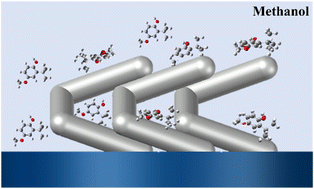Molecular–substrate interaction on dynamic SERS detection of butylated hydroxyanisole on a silver nano-tripod substrate†
Abstract
Surface-enhanced Raman spectroscopy (SERS) relies heavily on a substrate for highly sensitive detection, which may have poor performance due to weak adsorption of molecules on the surface. The substrate–molecule interaction is a crucial factor in the SERS detection of weakly adsorbed molecules. Herein, we performed a dynamic SERS detection of butylated hydroxyanisole (BHA) on a silver nano-tripod (AgNT) substrate and reported the instability detection process of BHA. The interaction of BHA molecules with the AgNT substrate was analyzed by the detected phenomena combined with molecular electrostatic potential (MEP) and SERS surface selection rules, and a dynamic adsorption model of BHA molecules was developed. The model postulates that the conversion of solution state for molecular adsorption orientation is the key to dynamic SERS detection. The signal acquisition time of BHA was extended from 1 min to 3 min by adjusting the detection solvent, which improved the practicality and operability of SERS detection. Combining surface adsorption analysis with the SERS process may provide a reference for the detection and analysis of other weakly adsorbed molecules.


 Please wait while we load your content...
Please wait while we load your content...